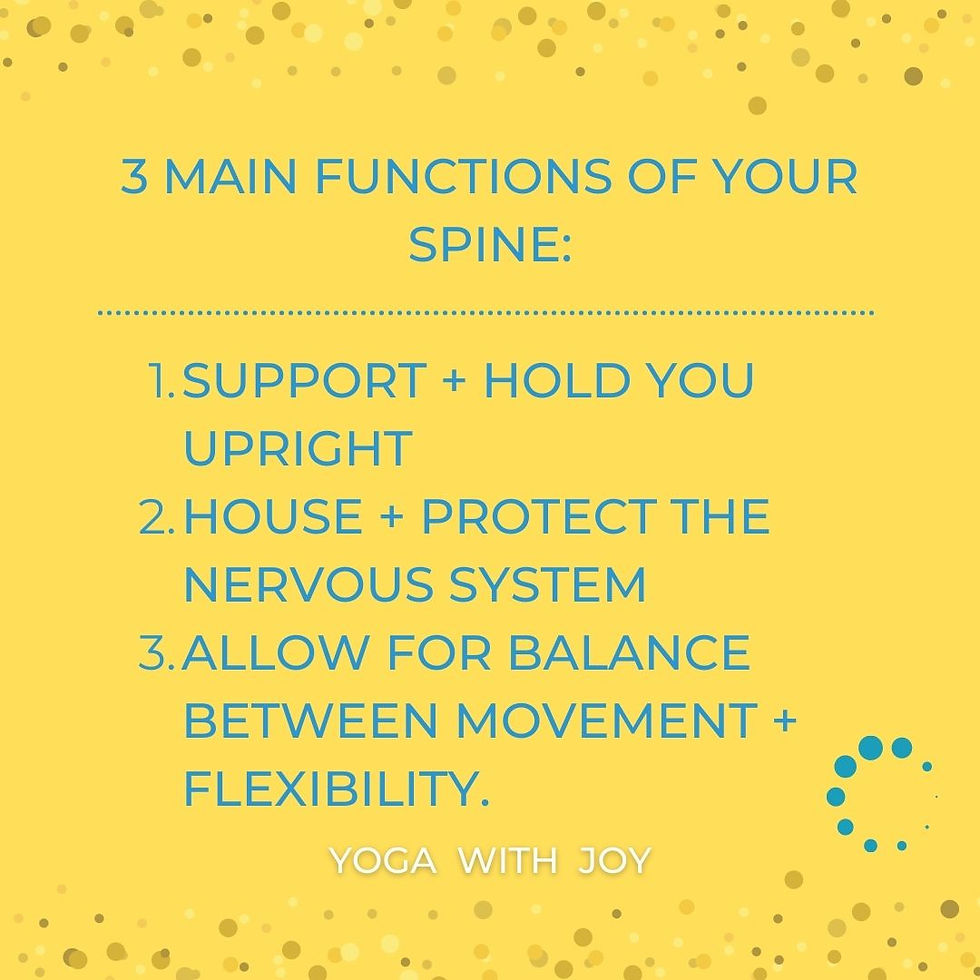3 Essential Jobs of Your Spine: Support, Movement & Protection
- Joy Zazzera

- Feb 23, 2021
- 3 min read
Updated: Aug 23

Considering our spine has three significant jobs to carry out relentlessly every day, it seems almost silly that we often neglect regular maintenance of everything that supports it. When the spine can do its jobs well, our posture is more efficient, our nervous system feels safer, and the rest of the body benefits too.
Let’s look at these three essential jobs — and how yoga therapeutics can help us connect to and support them.
Job #1: Support — Holding You Upright
Your spine’s first job is to support your body and hold you upright. Each vertebra is designed to bear weight and create a stable foundation for movement. Without this, even basic tasks like standing, walking, or sitting would collapse under gravity.
One simple (but not always easy) place to begin building awareness is with posture. Our stronger, superficial mover muscles — like the traps, lats, and sternocleidomastoid (SCM) — often work overtime, becoming tense and dominant. Meanwhile, the deeper stabilizing muscles — like the paraspinals and the deep flexors and extensors of the neck — tend to be weak and underactive.
These deeper stabilizers are sometimes called the “mindfulness muscles.” They aren’t easy to feel engage, but they’re essential for spinal support. The best part? The movements that target them are so subtle that anyone can learn to access them, especially with guidance from a skilled teacher.
Insight: Postures like Mountain Pose (Tadasana) or gentle spinal isometrics help re-educate the brain and body to share the load, teaching the deeper stabilizers to turn on and reducing chronic fatigue in the superficial muscles.
Job #2: Protection — Housing the Nervous System
The spine’s second job is to house and protect the nervous system. Encased within the spinal column, the spinal cord carries messages between brain and body. Every movement, sensation, and reflex relies on this protected channel.
Over time, the spine adapts not only to gravity, but also to our habitual movement and static postures. Our nervous system arranges the spine into its “preferred” patterns — simply because they’re familiar. That doesn’t mean we can’t change them. With gradual, mindful practice, we can re-educate the nervous system and create healthier postural choices.
Yoga therapeutics offers tools like Cat–Cow, Constructive Rest, and guided breathwork to improve circulation, restore balance, and protect nervous system function.
Insight: Gentle, intentional yoga helps quiet the “alarm signals” that can emerge when spinal tissues are compressed or irritated. Practices that emphasize safety and choice give the nervous system space to down-regulate, which is the foundation of healing.

Job #3: Movement — Balancing Stability & Flexibility
The third job of the spine is to allow balanced movement and flexibility. It must be stable enough to protect the nervous system, but mobile enough to bend, twist, and adapt to life.
Each region contributes differently:
Cervical spine (neck): Highly mobile for rotation and flexion.
Thoracic spine (mid-back): Anchors the ribcage with limited extension and rotation.
Lumbar spine (low back): Designed for flexion and extension but less rotation.
Yoga practices like Supported Side Bends, gentle Twists, and Backbends over props help restore healthy mobility while respecting these regional differences.
Insight: Research shows that active mobility — where strength supports range of motion — is more sustainable than passive stretching. Yoga therapeutics emphasizes this balance so the spine can remain resilient and adaptable. How Yoga Supports All Three Jobs of the Spine
Learning more about our spine, our tendencies, and any dysfunctions we may be experiencing allows us to step into new postural scenarios on the mat — with the purpose of increasing strength, stability, mobility, and efficiency.
Some simple ways to support your spine include:
Support: Mountain Pose, supported Bridge, and isometric core work
Protection: Breathwork, Restorative Yoga, and spinal awareness drills
Movement: Twists, side bends, and gentle mobility practices
And remember: other than the ability to breathe, there’s no prior yoga experience required. Just the desire to make better choices about how you move, feel, and live in your body.
Why Spinal Awareness Matters
Your spine isn’t just a column of bones. It’s the central axis of how you live, move, and experience the world. By honoring its three essential jobs — support, protection, and movement — yoga therapeutics gives us a way to move with more ease, regulate our nervous system, and make better postural choices in daily life.
When we meet the spine with awareness and consistency, we can create not only healthier posture, but also greater confidence, resilience, and connection with the body we live in.







Comments